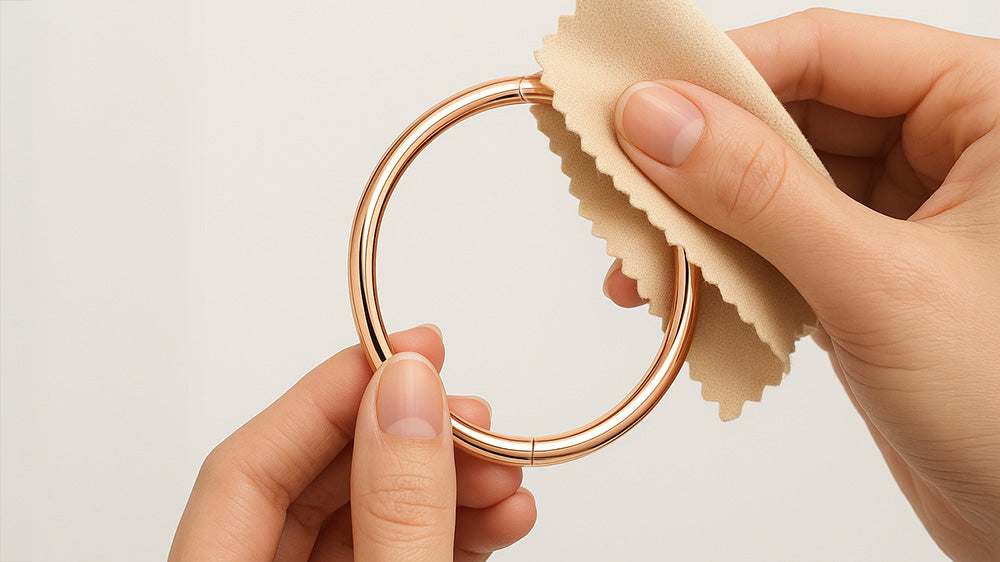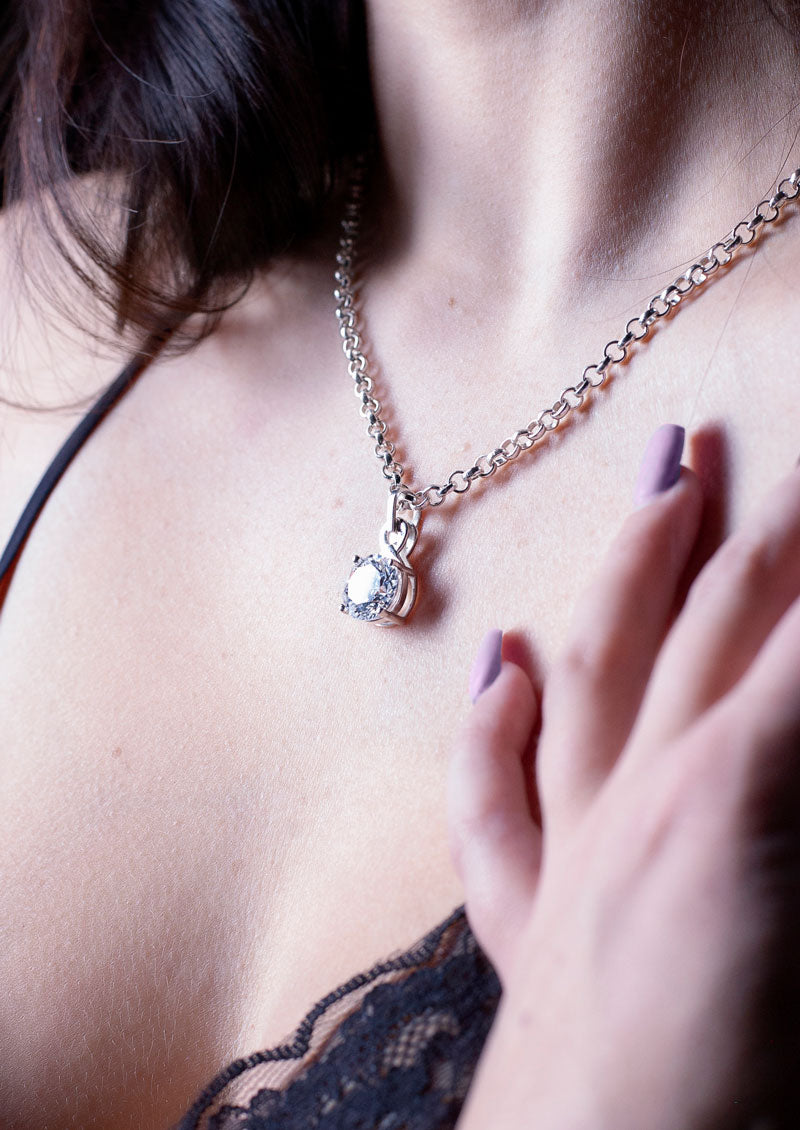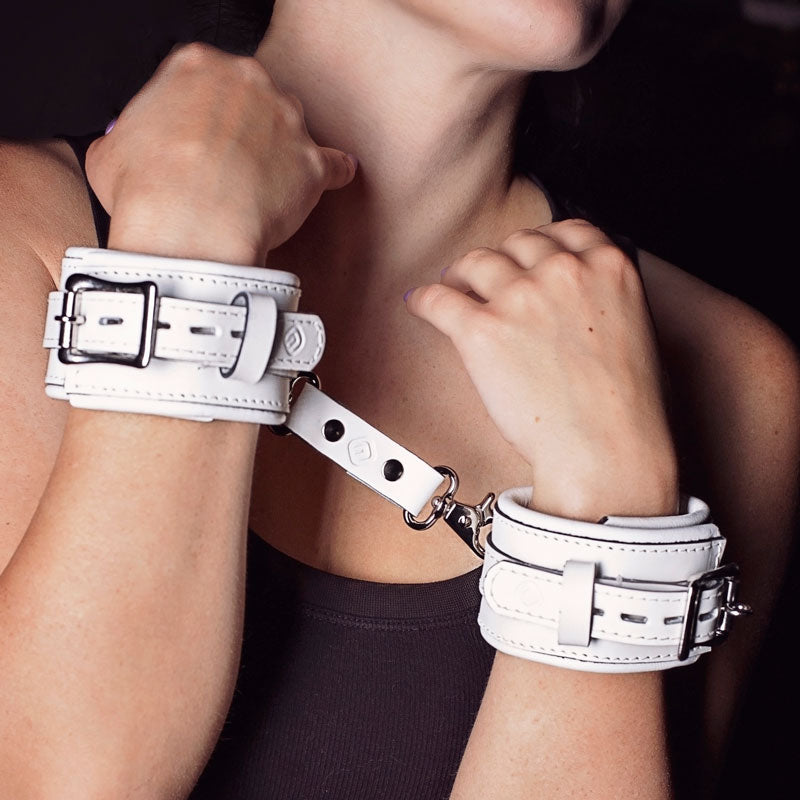The Science Behind Your Rose Gold Finish
Preventative Care Strategies for Rose Gold Finishes
How To Clean Your Rose Gold Finish
Understanding Normal Wear Patterns
That gorgeous rose gold finish you love is a remarkable feat of modern technology. In this guide, we explain the process we use to create our rose gold finish, why it sometimes changes appearance over time, and how to maintain its beauty.
Whether you've just received your first rose gold Eternity collar or have been collecting for years, you'll gain all the practical knowledge needed to protect and maintain this beautiful finish.
The Science Behind Your Rose Gold Finish
Rose gold is an alloy composed of gold, copper, and silver, with each metal playing a distinct role. Gold provides the base, copper contributes the pink color, and silver helps stabilize the mixture, preventing the copper from oxidizing too quickly.
For our products, the rose gold is applied as a finish using a Physical Vapor Deposition (PVD) process. In this process, vaporized atoms of rose gold travel through a vacuum and bond with the surface of the item being plated.
The beauty of using this process lies in its ability to preserve the exact atomic arrangement that gives the material its color, while creating an exceptionally durable coating.
However, the rose gold mixture still contains copper, which can react with environmental factors over time, resulting in a change of the color and hue of the finish.
Fortunately, proper maintenance and care can reduce this effect and keep your finish looking great.
Causes of Rose Gold Color Changes
Copper stands out among metals for its tendency to interact with its environment. Much like how a copper penny gradually turns brown or the Statue of Liberty transformed from copper-colored to green, the copper in your rose gold finish naturally wants to react with elements in its surroundings. While the PVD process we use creates strong molecular bonds that resist this reactivity, microscopic interactions can still occur over time.
These are several of the day-to-day chemical processes that can affect your rose gold jewelry's appearance:
Surface Oxidation
When copper atoms in the coating encounter oxygen from the air, they can form copper oxide. This process is typically slow with PVD coatings, but it accelerates when exposed to moisture or certain chemicals. The resulting oxide layer, though microscopically thin, can make your finish appear slightly darker or less vibrant.
Chlorine Exposure
Swimming pools and hot tubs can present a particular challenge because the higher levels of chlorine readily react with copper. These reactions can create copper chloride compounds that may alter the coating's color. Even brief exposure to chlorinated water can initiate chemical changes that develop over time. If you expose your finish to chlorine, rinse and dry thoroughly with fresh, clean water afterwards.
pH Sensitivity
Copper responds distinctly to varying pH environments. Skin acidity, personal care products, and household cleaners all introduce different pH levels that may create subtle color shifts in your rose gold finish.
Salt and Sweat
Perspiration contains salt and other minerals that can interact with copper atoms. These interactions may create small areas where the coating's color differs from the original rose gold shade. Regular exposure to salty environments, including ocean air or sweat, can accelerate these changes.
Temperature Effects
Heat causes metals to expand slightly, while cold causes them to contract. These thermal cycles can create microscopic spaces where moisture and chemicals might penetrate more easily, potentially accelerating copper's natural reactivity.
Preventative Care Strategies for Rose Gold Finishes
Now that we understand it’s the copper in rose gold that is the primary culprit in causing the finish color to shift, we can take steps to minimize the effect.
Regular Cleaning
Timely cleaning removes potentially reactive substances before they affect your jewelry's appearance. For best results, perform a quick wipe-down with a microfiber cloth after each wear. Schedule a thorough cleaning every 2-3 weeks for pieces worn regularly.
Moisture Management
Keeping pieces dry and removing them before swimming prevents conditions where copper reacts most readily. Always remove your jewelry before showering, swimming, or bathing. If accidental water exposure occurs, dry your piece thoroughly within 5 minutes using a soft, clean cloth.
pH-Neutral Products
Using only gentle, pH-balanced cleaning solutions helps maintain the stable environment that preserves rose gold's original color. Replace your cleaning products every 6 months to ensure effectiveness. When introducing new personal care items into your routine, test them for 24 hours before wearing them alongside your jewelry.
Environmental Awareness
Limiting exposure to chemicals, salt water, and temperature extremes helps maintain the copper's stability within the PVD coating. It is best to remove your item when you are going to be exposed to salt water or high temperatures, when working out, and anytime you are showering, bathing, or applying skin care products.
If you’re committed to 24/7 wear and cannot remove items even briefly, maintain a consistent cleaning schedule using gentle, alcohol-free wipes designed for sensitive jewelry once daily, preferably after any exposure to water, chemicals, sweat, etc.
When not wearing your item, it is best to store it away in a cool, dry place away from direct sunlight, heat, or humidity.
How To Clean Your Rose Gold Finish
When you clean your jewelry, you're doing more than just removing everyday dirt – you're preserving the special blend of materials that creates rose gold's signature warmth.
The following steps have been carefully developed to provide thorough cleaning while protecting the finish from oxidation and discoloration.
Required Cleaning Supplies
To properly clean your rose gold finish, you'll need:
- Mild, non-abrasive soap: Avoid anything with harsh chemicals or bleach. A mild dish soap usually works great.
- Soft microfiber or cloth: Microfiber or a jewelry cleaning cloth: These are ideal as they are gentle on the metal and won’t scratch the surface. For best results, use two; one for washing and one for drying.
- Clean, lukewarm water: It should be just warm enough to feel comfortable to soak your hand in. If the water is too hot, it can affect the finish.
- Soft-bristled brush: A baby toothbrush or dedicated jewelry brush can help get into the nooks and crannies, like the hinge and clasp areas on your collar.
- Clean bowl or container: You’ll need this to mix your soap solution or soak your item. Glass or plastic is preferred. Do not use metal.
- Timer: A phone or watch is fine (optional)
- A soft surface for your workspace
Step-by-Step Cleaning Process
STEP 1: Preparation
- Choose a well-lit, clean workspace away from drains
- Lay down a soft cloth or paper towels to prevent scratches
- Fill a clean bowl with the lukewarm water
- Add a small amount of mild soap (approximately 1/4 teaspoon per cup of water)
- Have your cleaning supplies within easy reach
STEP 2: Initial Cleaning
- Dampen a clean microfiber cloth in the soap solution
- Starting at the top of your piece, gently wipe in small, circular motions
- Pay special attention to areas that touch the skin regularly
- Use extremely light pressure—let the soap do the work
- Clean all surfaces systematically to ensure no spots are missed
STEP 3: Detail Cleaning (If Needed)
- Wet the soft-bristled brush with soap solution
- Very gently brush complex areas using light, circular motions
- Focus on joints, closures, and textured surfaces
- Spend no more than 30 seconds on any single area
- Avoid aggressive scrubbing that might damage the finish
STEP 4: Rinsing Process
- Empty the soap solution and fill the bowl with clean, lukewarm water
- Hold your piece under the water, rotating to rinse all surfaces
- Change the water and repeat until all soap residue is gone
- Perform a final rinse under slowly running lukewarm water
STEP 5: Drying and Final Care
- Pat dry with a lint-free cloth immediately after rinsing
- Pay special attention to crevices and joints where water might collect
- Allow to air dry on a clean microfiber cloth for 30 minutes
- Gently buff with a clean, dry section of microfiber cloth
Daily Care and Maintenance
Regular maintenance extends the life and beauty of your rose gold finish. Follow these guidelines for optimal care:
Daily Best Practices
- Dry your item immediately after showering, swimming, or bathing
- Put jewelry on after applying lotions, perfumes, or cosmetics
- Take off before exercise or activities causing perspiration
- Wipe with a clean, dry microfiber cloth after each wear. Even better: Use a jewelry polishing cloth.
Routine Maintenance
At least once a month:
- Perform a quick inspection for any signs of wear or buildup
- Complete a thorough cleaning following the detailed steps above
- Check all closures and mechanisms for proper function
- When not wearing, store properly in a soft pouch or dedicated jewelry box
- Inspect closely for any changes in color or finish
- Document any concerns and contact customer service if needed
- Evaluate wear patterns and adjust wearing habits if necessary
Storage Requirements
When you are not wearing your item, proper storage significantly impacts the longevity of your rose gold finish:
- Store pieces individually in soft pouches or compartments
- Maintain a consistent, cool temperature away from direct sunlight
- Use silica gel packets in storage areas to control moisture
- Never store in plastic bags or non-breathable containers
- Keep away from harsh chemicals or cleaning supplies
Understanding Normal Wear Patterns
Your rose gold finish will naturally develop certain characteristics over time:
- Areas of frequent skin contact may develop a subtle patina
- Closures and moving parts might show minimal wear signs
- Surface appearance may vary slightly based on lighting conditions
- Microscopic scratches typically blend naturally over time
Frequently Asked Questions
How often should I perform a complete cleaning?
Monthly deep cleaning is recommended for regularly worn pieces. Increase frequency if exposed to excessive sweat or chemical products.
Can I use ultrasonic cleaners?
No. Ultrasonic cleaning may damage the finish. Stick to the gentle hand cleaning methods outlined in this guide.
What should I do if I notice color changes?
Document any changes you notice with photos and contact customer service. Often, a thorough cleaning can resolve apparent color variations, provided the finish has been properly maintained.
What causes the most damage to the rose gold finish?
Harsh chemicals, abrasive materials, and prolonged exposure to body oils cause the most significant damage.







